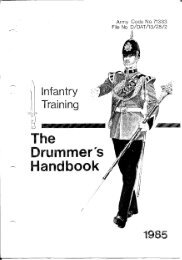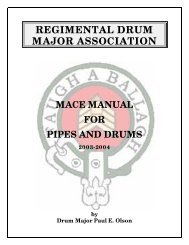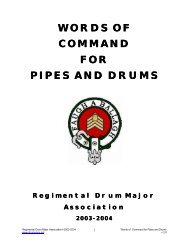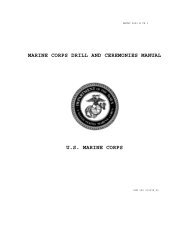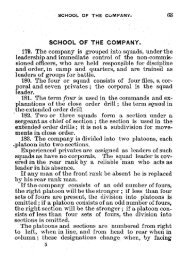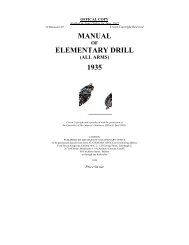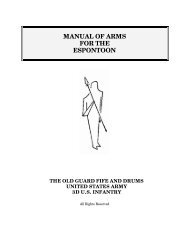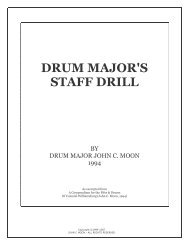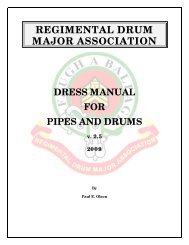The Military Band - Regimental Drum Major Association
The Military Band - Regimental Drum Major Association
The Military Band - Regimental Drum Major Association
Create successful ePaper yourself
Turn your PDF publications into a flip-book with our unique Google optimized e-Paper software.
91. <strong>The</strong> Mace<br />
<strong>The</strong> drum major's mace, like the baton, is used to<br />
band. Its component parts are the ball, staff, ferrule,<br />
and chain. <strong>The</strong> mace is derived from the ancient<br />
weapon of mace and chain which was<br />
swung above the head to clear a path for marching<br />
troops to follow. <strong>The</strong> following paragraphs<br />
prescribe the various positions of the mace for<br />
Army bands.<br />
92. Order Mace<br />
<strong>The</strong> position assumed by the drum major while<br />
he is at halt is known as Order Mace, which is<br />
executed as follows:<br />
a. <strong>The</strong> right elbow is held close to the side with<br />
the right hand grasping the mace just below the<br />
ball, fingers together, and thumb perpendicular<br />
toward the ball. <strong>The</strong> ferrule is in line with the<br />
right toe-cap, and the right forearm forms a 300<br />
angle to the body (fig. 32).<br />
b. <strong>The</strong> left arm hangs straight from the shoulder.<br />
Section VI. MANUAL OF THE MACE<br />
93. Parade Rest<br />
This movement and command is executed as pre- Figure 32. Order mace.<br />
scribed in FM 22-5, except that the drum major<br />
moves the mace across the right side of the body,<br />
lifting the ferrule over the shoe, and placing it<br />
between the feet in line with the toe-caps. <strong>The</strong><br />
thumb is brought down to the fingers and the left<br />
hand crosses to grip below the right hand (fig. 0,<br />
33).<br />
94. Mace Twirl<br />
a. Primary Twirl. <strong>The</strong> mace twirl is a circular<br />
motion of the mace which is performed in front<br />
of the body and is designed to attract the attention<br />
of the bandsmen in order that they may be<br />
prepared for the mace signal to follow. When<br />
practicable, the twirl should precede all preparatory<br />
signals. It is executed in the following manner:<br />
(1) <strong>The</strong> drum major moves the mace from<br />
the order position or the carry position to a vertical<br />
position in front of the body ((1), fig. 34).<br />
(2) He swings the ferrule in a slight arc to<br />
the right and then swings the mace clockwise<br />
through one complete circle, using both hands to<br />
control and guide the mace ((2), fig. 34).<br />
(3) Upon completion of the circle, the mace<br />
should be grasped by the right hand, and the left<br />
arm dropped smartly to the side ((3), fig. 34).<br />
<strong>The</strong> mace is then immediately moved to the start- Figure 33. Parade Rest.<br />
45



